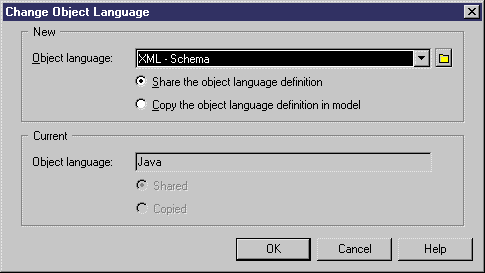

Chapter 2 Getting Started with an Object-Oriented Model
Changing the object language of an OOM
You can change the object language of a model at any time.
You may be required to change the object language if you open an OOM and the associated language file has been deprecated, or is otherwise unavailable. In this case the "Choose Object Language" dialog box will be displayed, inviting you to select a language from the list.
Object languages are frequently updated in each version of PowerDesigner and it is highly recommended to accept this change, or otherwise you will not be able to generate for the selected language.
For more information on how to replace object languages, see the "Replacing an object language from version 7 or 8" section, in the "Migrating from previous versions" document , available in the PowerDesigner Printable Docs directory.
 To change the object language of a model:
To change the object language of a model:
- Select Language→Change Current Object Language to open the Change Object Language dialog box .

- Select an object language.
- Select one of the following radio buttons:
- Share the object language definition – use the original object language file in the "Resource Files\Object Languages" directory. Any changes made to the object language are shared by all linked OOM.
- Copy the object language definition in model – make a copy of the original object language file in the "Resource Files\Object Languages" directory. The current object language is independent of the original object language, so modifications made to the object language in the Object Languages directory are not available to the OOM. The copied object language is saved with the OOM and cannot be used without it.
WARNING! Caution
PowerDesigner is delivered with a set of object languages. It is strongly advised to make a backup copy of each object language before you start modifying them.
- Click OK.
A message box informs you that the current object language has been changed.
- Click OK.
|
Copyright (C) 2006. Sybase Inc. All rights reserved.
|

|


![]() To change the object language of a model:
To change the object language of a model:
